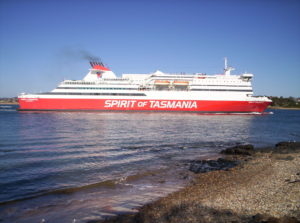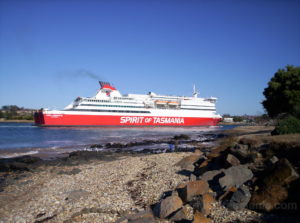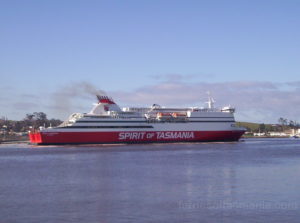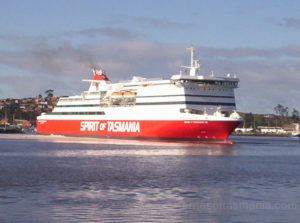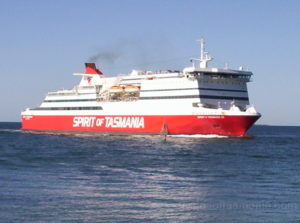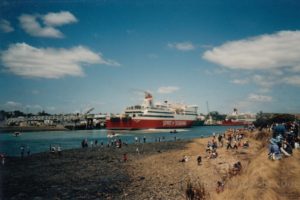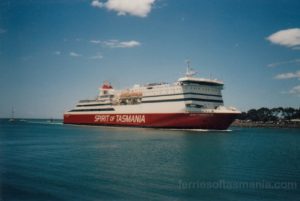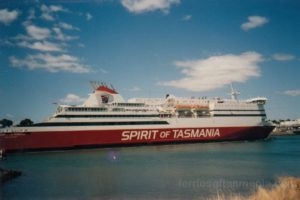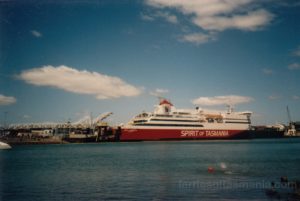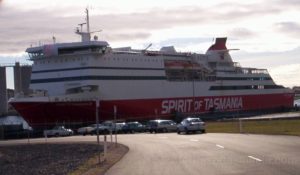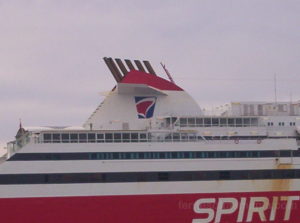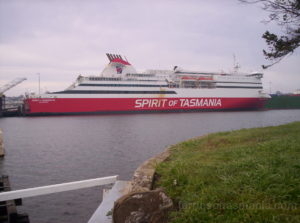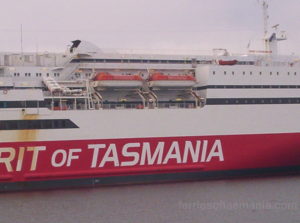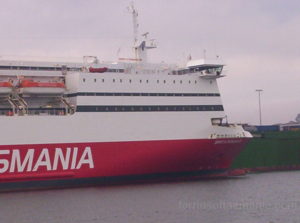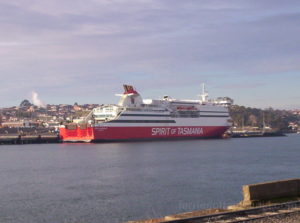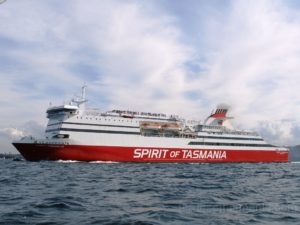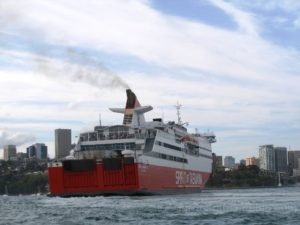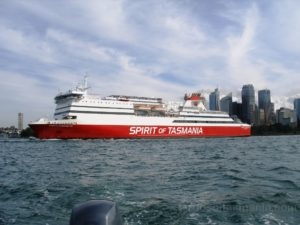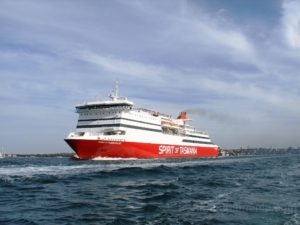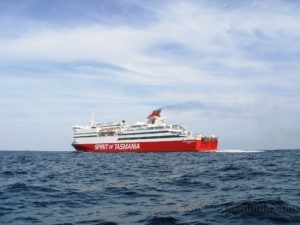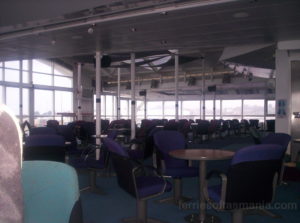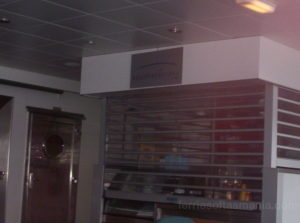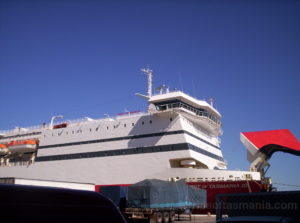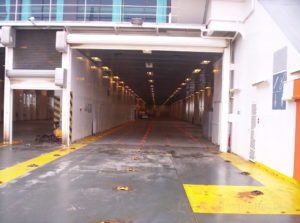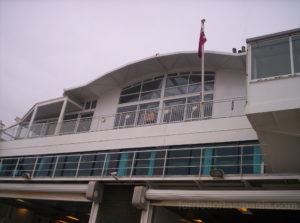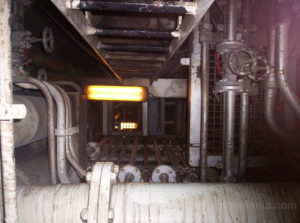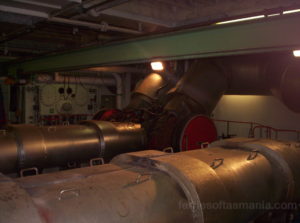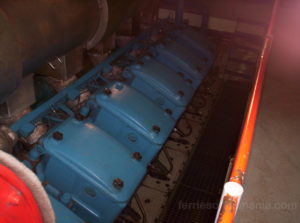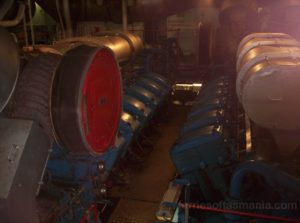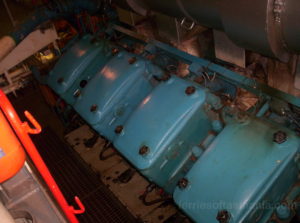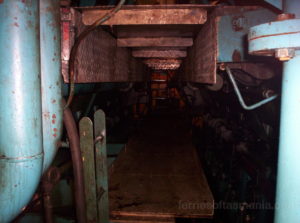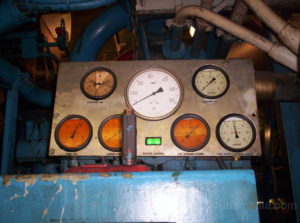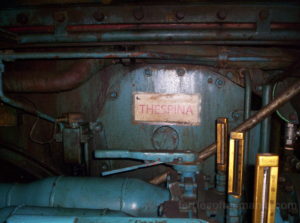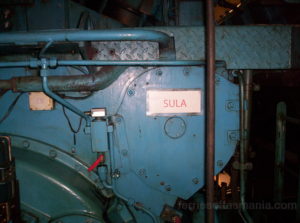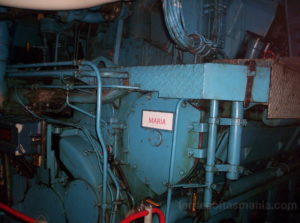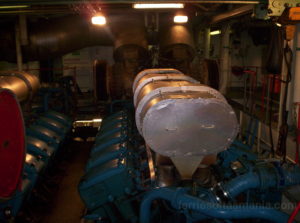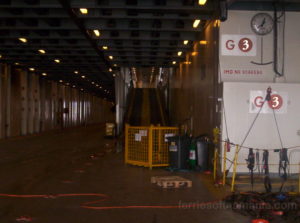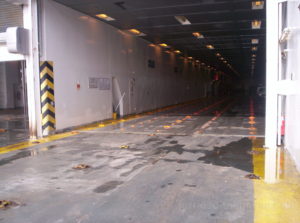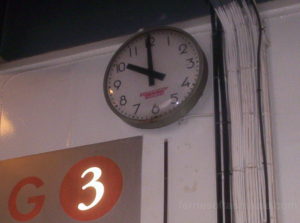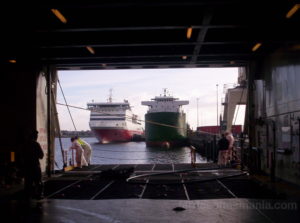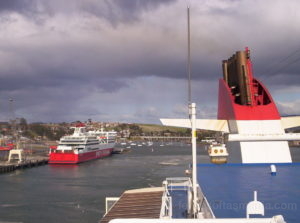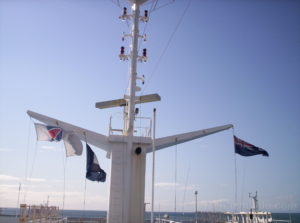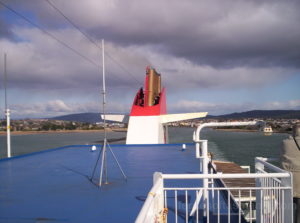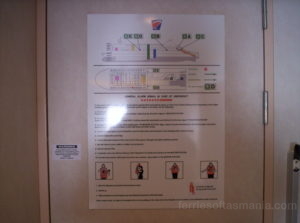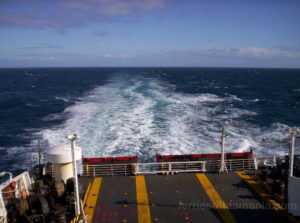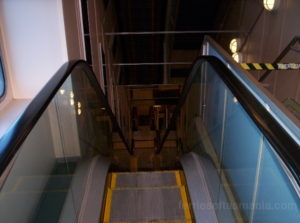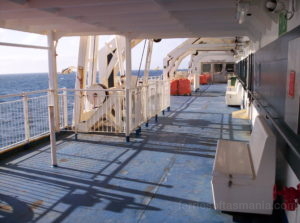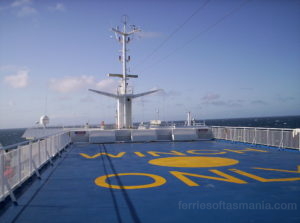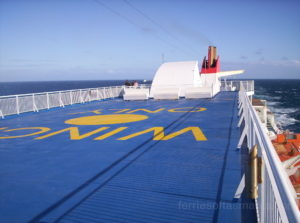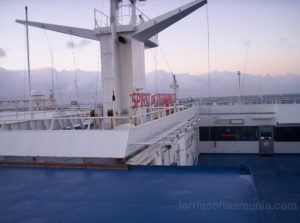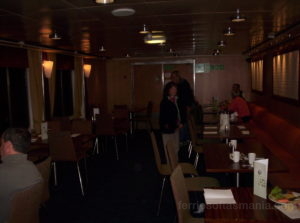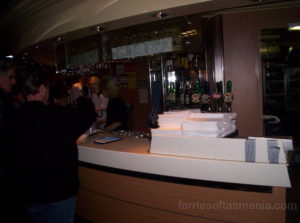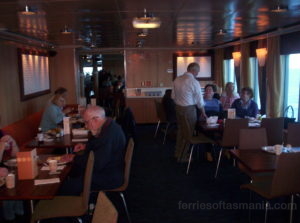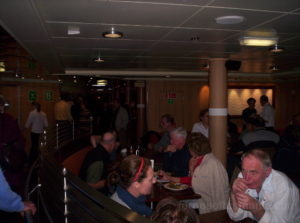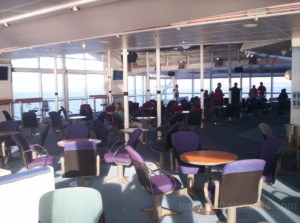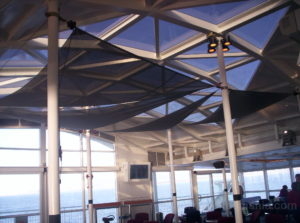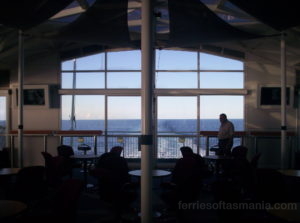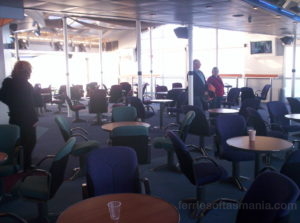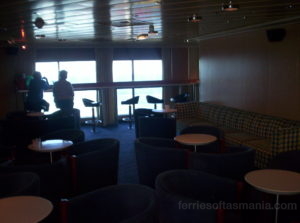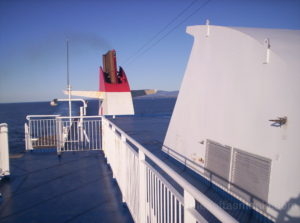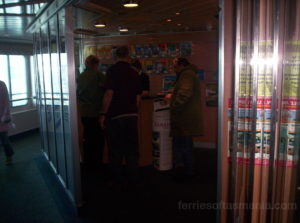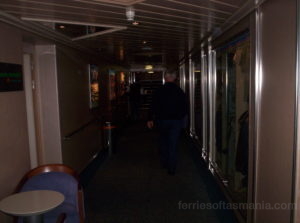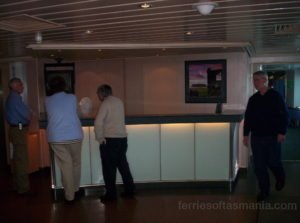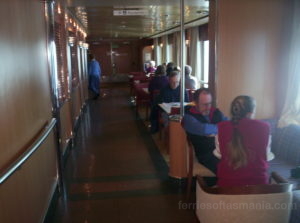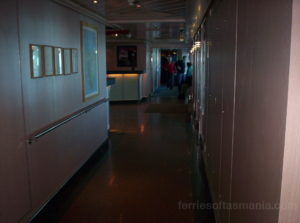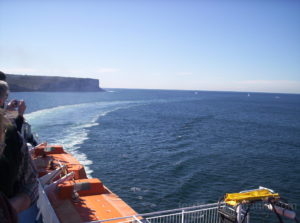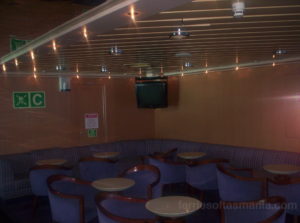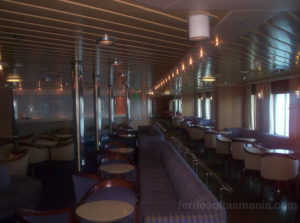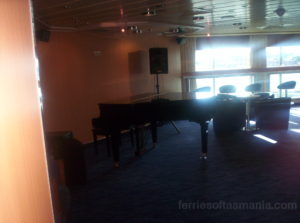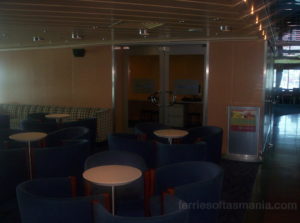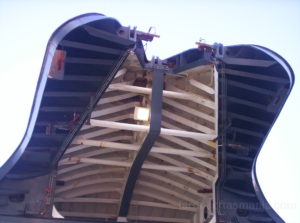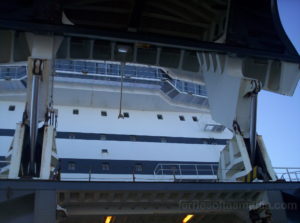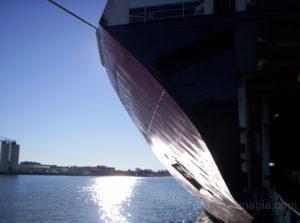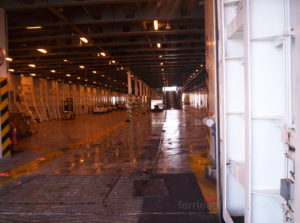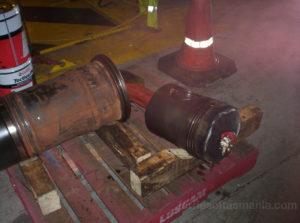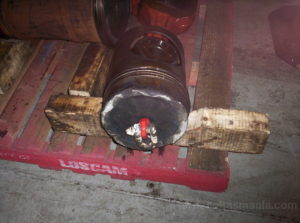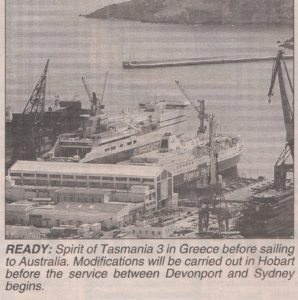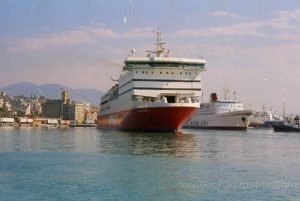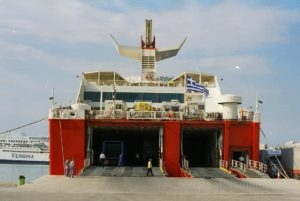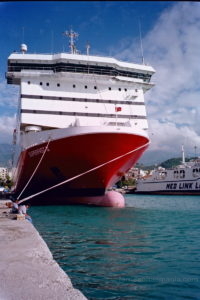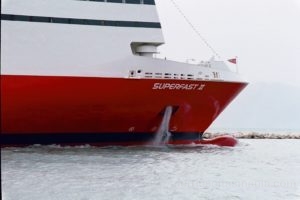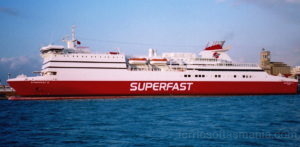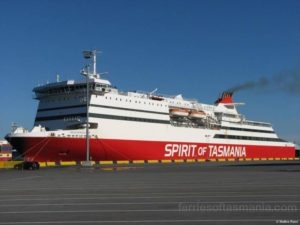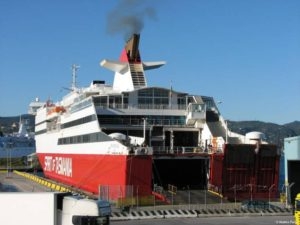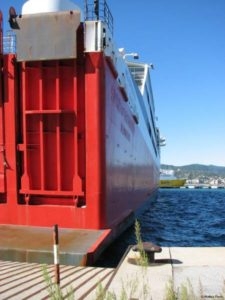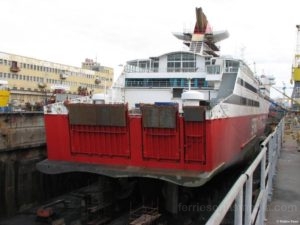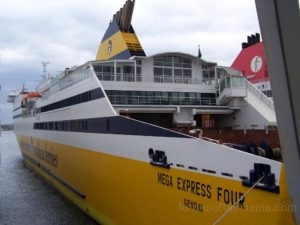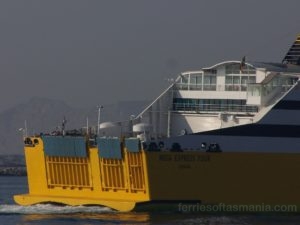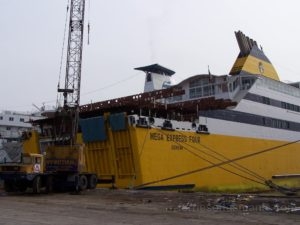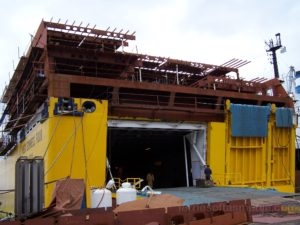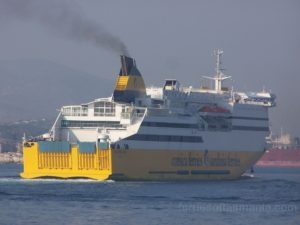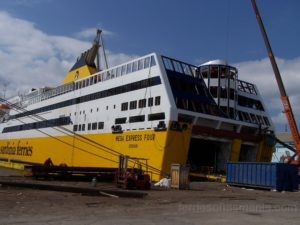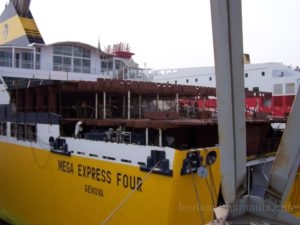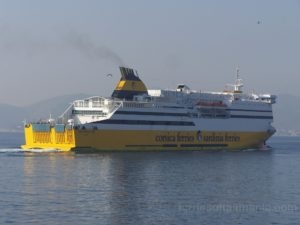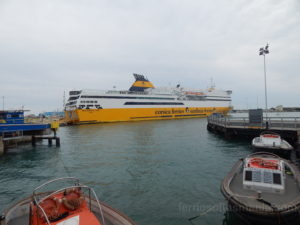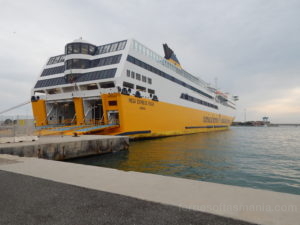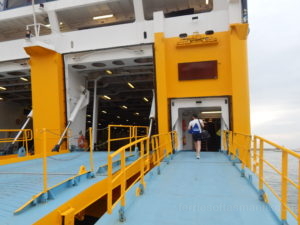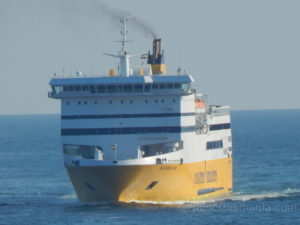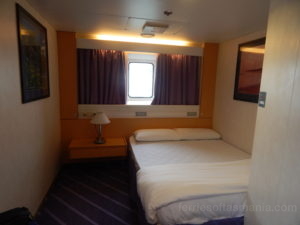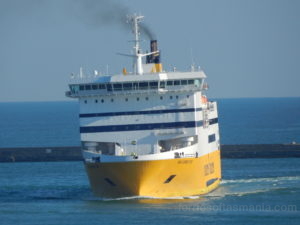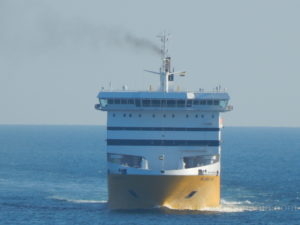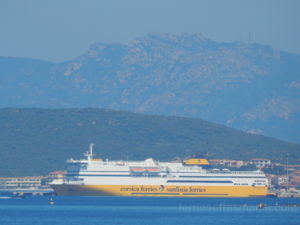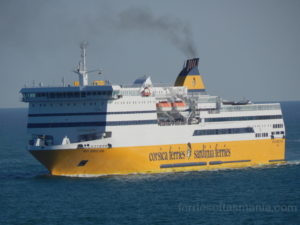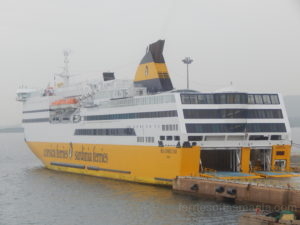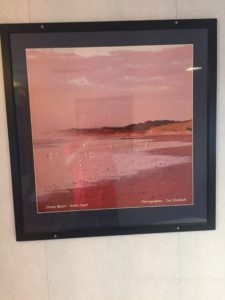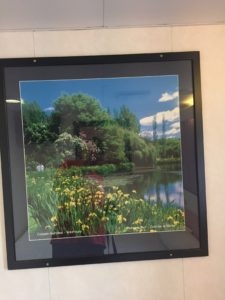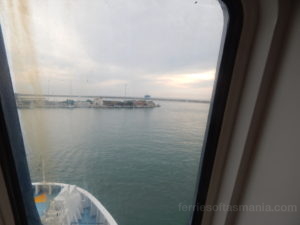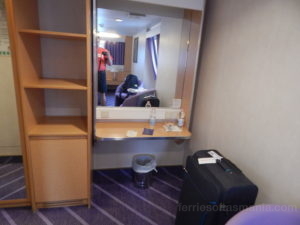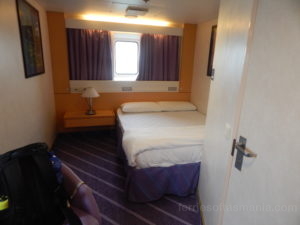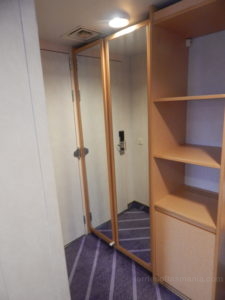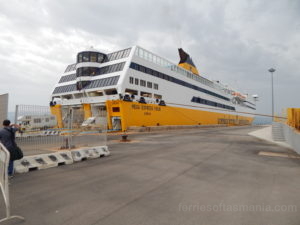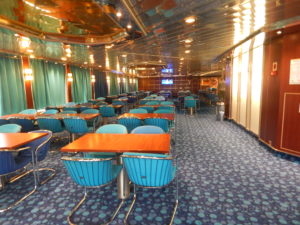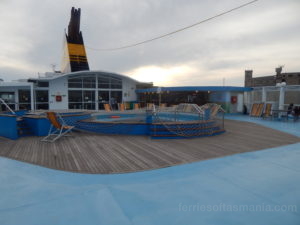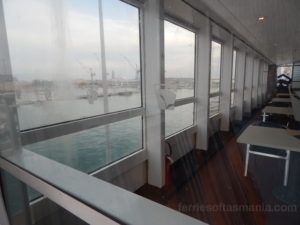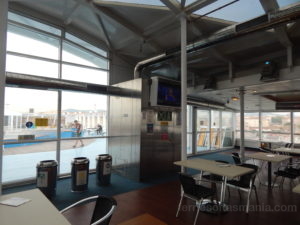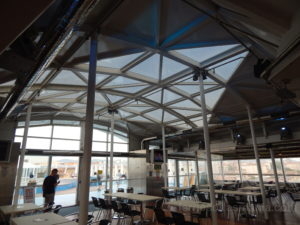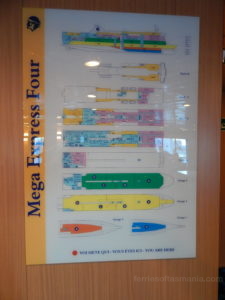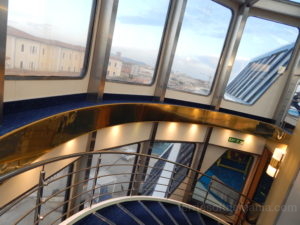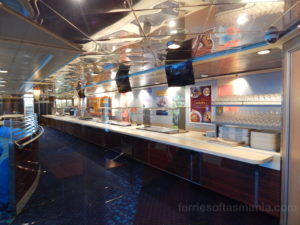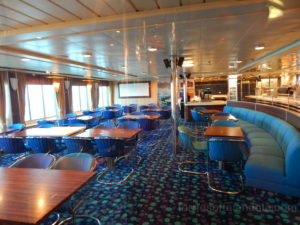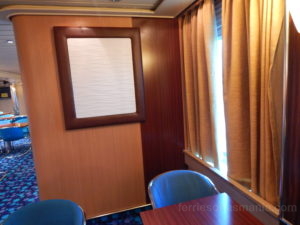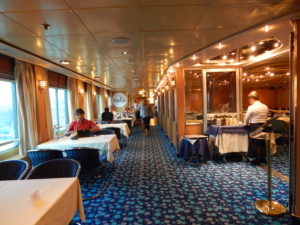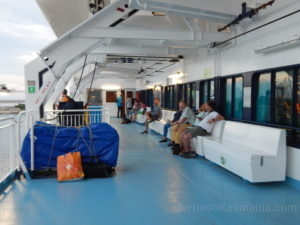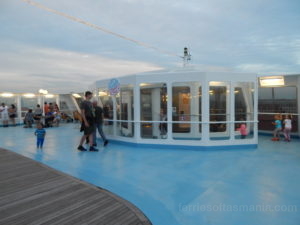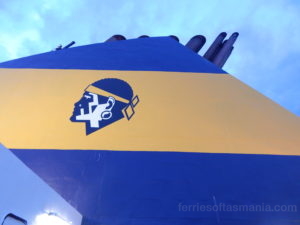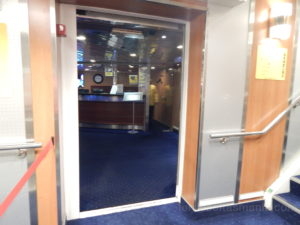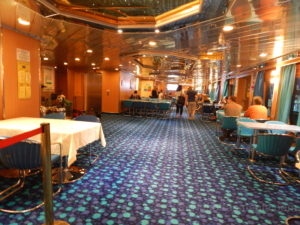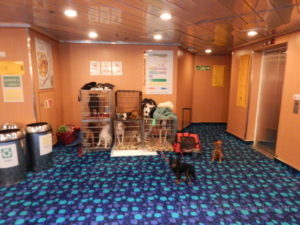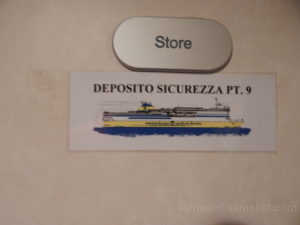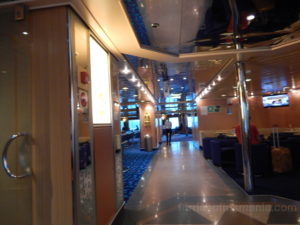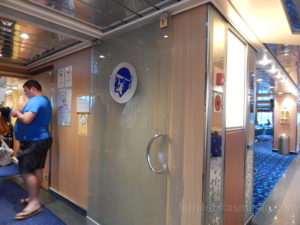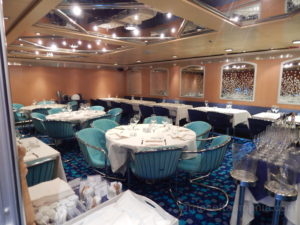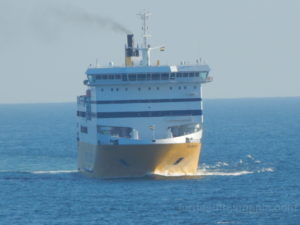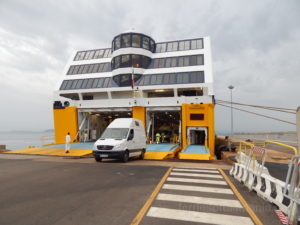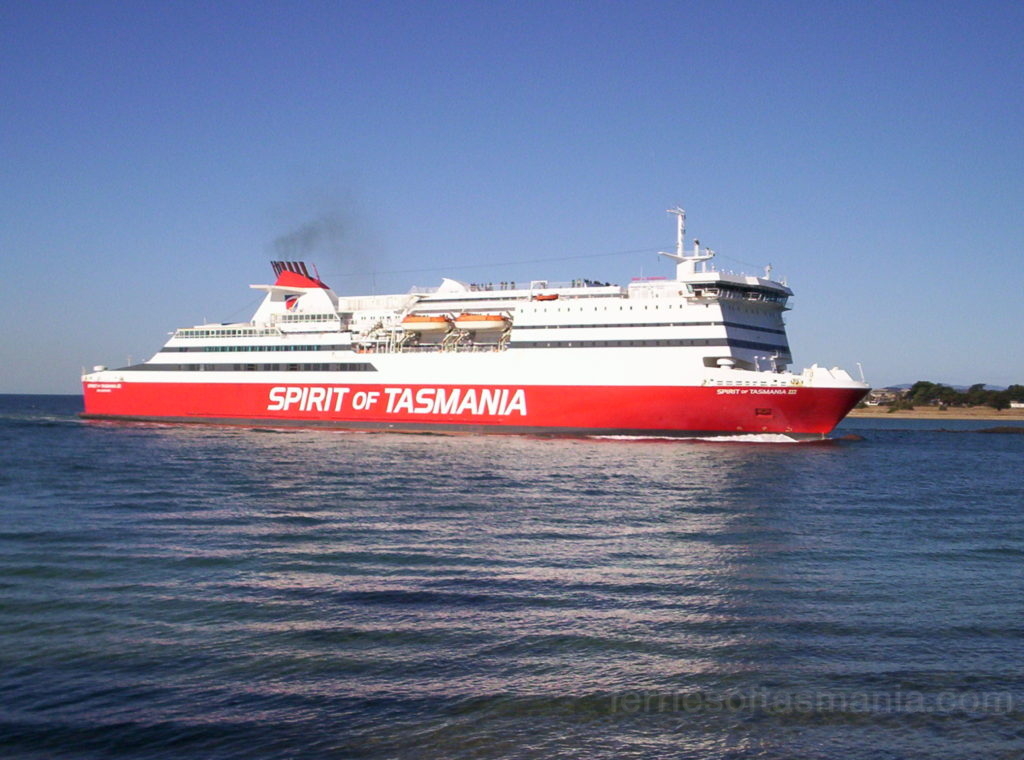
Photo: © Mitchell Bruce
Builder: Schichau Seebeckwerft, Bermerhaven
Year of build: 1995
Ship yard number: 1088.
IMO Number: 9086590.
Call sign: ?
Length: 173.70m.
Width: 24.00m.
Daft: DWL 6.41m / Scantling: 6.56m.
GT/ NT / DWT. 23,663 t / 8870 t/5717 t.
Main engines. Four (NSD) Sulzer 12ZAV40S Diesels.
Power rating: 31680 kW.
Gear ratio: 510 rpm to 147 rpm.
Service speed: 27.3 knots
Passengers capacity: 626 beds in 200 cabins.
1400 with deck passengers. (No Deck pax on Syd service)
Cars: 830
Total Lane meters: 1,675m
Spirit of Tasmania III operated under TT-Line from 2003 until 2006, sailing the Devonport to Sydney route. The ship was built in 1995 as Superfast II for Attica Enterprises subsidiary, Superfast Ferries. This ship, along wither her sister, Superfast I were pioneers into a new era of travel between Italy and Greece. Indeed they revolutionized the speed at which ferries traveled on the route and in Europe in general.
To understand the concept of this ship and her sister, and indeed the 10 Superfast ferries that followed, I feel I need to give some background story on how the idea was conceived.
Superfast Ferries was the brain child of Pericles Panagopulos and his son Alexander. Pericles had started working with ships at a young age at a relative’s shipping company, first in a cargo division, later into the passenger sector. He later moved on to become president of Sun lines, a Greek cruise line in the 1960s. By 1972 he left to start his own company, Royal Cruise Line. He started his company with a new ship, Golden Odyssey later getting a another vessel second hand, Crown Odyssey. In 1989 he sold the whole operation to Kloster Group of Norway.
In 1992 Pericles Panagopulos brought a dormant company, known as Attica Flower-Mills, renaming it Attica Enterprises. In 1993 Pericles and his son Alexander came up with the idea of operating high speed mono hull ferries between Italy and Greece. The ferries that were sailing this line were mostly old and slow. There was a civil war happening in the former Yugoslavia (Country of the Balkans) and this made it almost impossible to drive to continental Europe from Greece, especially effecting trucks. So the idea of a fast Ro/Pax with high Vehicle capacity was born. The name Superfast, said to be a very easy name to remember, and tells everyone what the company is about right in the name, with red hull, inspired by Ferrari. (Everyone knows red is faster, right?)
An order was placed at a German yard, Schichau Seebeckwerft (Who built the Spirit of Tasmania as Peter Pan back in 1986) in 1993. At the time the German government was offering incentives/grants to companies for new innovative technologies, which these ships qualified. The hull form was refined in the Vienna model basin, consisting of an “Extreme” bulbous bow, a V shaped stern with “soft tunnels” in the propeller area and a duck tail, which was said to increase hull efficiency by 11%.
Along with these “ground breaking” ships, the marketing was very aggressive, even before the ships were completed many people knew about Superfast Ferries. Superfast I & II achieved 30.4 knots on trails, even though the contract speed was 27 knots. Vibration was very minimal, to the pleasure of the Panagopulos’s.
The interiors were designed by Yran & Storbraaten from Oslo, Norway. The interiors were said not to be overly luxurious, but very practical and fitting of the market they were built.
Speed was the most important feature of the ship, being powered by X4 12 cylinder Sulzer 12VZA40S. The reason for the choice was lack of room in the hull, developed for speed. Only 13.5 meters was available for length of the engine room.

Photo: © Klas Brogren, Cruise and Ferry Guide 96. (shipPax)
On the 14/1/1995 Superfast II was launched, a few months later on 25/3/95 Superfast I & II were baptized in a double ceremony. On the 31/5/95 Superfast II was handed over at Bermerhaven, to Superfast Ferries. She sailed to Patras Greece to enter service. On 11/6/95 she made her maiden voyage to Ancona Italy, only 8 weeks after her sister had begun the service. They were the fastest ships on the line, crossing in 20 hours, the closest being Aretousa of Minoan lines, at 24 hours. Minoan Lines had ordered Aretousa only days after Attica Enterprises ordered Superfast I & II.
All other ships on the line from Italy to Greece were far slower, at up to 35 hours. To make a comparison of the competition, the sister ship to the Abel Tasmania, Fedra was sailing the an Adriatic line in 1995. Superfast I & II were an instant success with passengers and truck operators, often owner operators. The “new” factor being very attractive to passengers, and also the fact you get to your holiday sooner. At the time Superfast used the marketing slogan “2 days more Holiday” in comparison with rival companies.
One of the biggest problems with the operation was turn around times. In Greece and Italy terminal infrastructure is almost non existent when compared to Northern Europe, and even here in Australia. This meant the ship must dock stern first at both ends of the Adriatic. A tilting ramp was fitted to allow cars and trucks to get to the upper deck. Superfast II also had a two cellar car decks, G1 and G2 with access from the main deck via a hatch in the floor, a couple of hundred cars can be squeezed down there. The ships had been built with all the latest equipment for loading and unloading, such as bow door and double deck loading. There was a hope at Superfast that the authorities would allow them to build, at their own expense, double deck loading infrastructure and passenger terminals with gangways to the ships, but this never was allowed to happen. The main reason all this extra equipment was installed in the ships.

Photo: © Proud_ionian, Ship friends
Superfast II settled into her line of Patras- Ancona, operating successfully. So successfully, only 12 months after delivery, Superfast Ferries placed an order for an additional two ferries. On delivery of Superfast III & Superfast IV, Superfast II, with her sister were replaced on the Patras to Ancona route, being deployed on a new route, from Patras – Igoumenitsa – Bari. This was a fair bit shorter, but still required the ships to sail at 27 knots over night and a day sailing back in the peak season.
In 1999, after the fire aboard Superfast III, Superfast II was again placed on the Patras – Ancona route for four months, whilst Superfast III went to Germany to be repaired. After she was back, Superfast II returned to the Patras – Igoumenitsa – Bari route.

Photo: © T.S.S Apollon, nautilia.gr
In September 2001 representatives from TT-Line Tasmania inspected Superfast II and her sister to replace the Original Spirit of Tasmania. They were “top of the list” for some time, but would require quite some modification, so were let down when Attica offered the newer and faster Superfast III & IV at a higher price, which was accepted.

Scan: Mitchell Bruce collection (The Advocate newspaper)
TT-Line officials again inspected Superfast I and II in 2003, looking for a ship suitable to open the new Devonport Sydney line. Superfast II was inspected by a delegation from TT-Line and government officials, including Tasmanian Premier Jim Bacon in June of 2003. On 3/8/03 upon arrival back in Tasmania, Jim bacon announced at a press conference in Hobart that a deal had been finalized for the purchase of Superfast II, to be renamed Spirit of Tasmania III. The actual price was kept secret, at the request of Attica Enterprises, but the government had allocated AUD$105 million to the purchase, delivery and modifications to the ship. The start date was set to be 15 January 2004 from Sydney.
A few weeks prior to the hand over, senior officers from TT-Line joined the ship on the Patras – Igoumenitsa – Bari route for familiarisation of the vessel.

Photo:© Costas Sarlis
On the 30/9/2003 Superfast II was handed over to TT-Line, and sailed to the
Neorion Ship yard, on the Greek Island of Syros. She underwent some works, including repainting the whole vessel, removal of the swimming pool on the aft sun deck, the propellers taken off to remove fishing line wound around the shafts, and the removal of the trademark Superfast wing tips.
She set off on the evening of 10/10/03 from Syros bound for Tasmania, under the command of captain Glenn Cole. She passed through the Suez Canal and crossed the Indian ocean, arriving Fremantle for Bunkering on 27/10/03. She departed and headed for Hobart, crossing the Great Australian bight, encountering some rough weather but took it in her stride. She docked at Macquarie wharf, berth No 6 early on the morning of 30/10/03. Work began almost immediately, only the next day the prefabricated deck house sections were lifted into place on deck 10, already with cabins installed. All the through deck connections for black and grey water had been installed by a team of technicians from Tasmanian based Taylor Bros, who had joined the ship in Syros and worked during the voyage to Tasmania, installing the plumbing. This new section contained 32 new crew cabins, each with a porthole and private facilities for each crew member. Among the other works carried out in Hobart was the covering of the old pool deck, making it into an enclosed atrium. Also enlarging the restaurant, to cater for the whole complement of passengers, as breakfast and dinner were going to be included in the fare of passengers. Turning the forwald half of the old air seat lounge into a cinema and at the aft section into a video games room, with X-box and the like. Refurbishment works turned the old À la carte restaurant onto a coffee shop and old casino into a piano bar. The refit cost AUD$8 million.

Photo:© Mitchell Bruce
On the 2/1/04 at 8am Spirit of Tasmania III departed Hobart with 500 passengers plus invited guests, bound for Devonport for her first arrival. She sailed up the east of Tasmania, keeping close so passengers could view the ship, but also so people could see the ship from the island. She arrived to much fanfare as thousands of people lined the Mersey to see their latest ferry arrive for the first time. On 4/1/04 Spirit of Tasmania departed Devonport headed to Melbourne, where she docked for a day, whilst travel agents and invited guests looked over the vessel. On 6/1 she departed Melbourne and headed to Sydney where she arrived at 11am on 7/1, berthing at the overseas passenger terminal where cruse ships dock. She was greeted by Tasmanian premier Jim Bacon, meeting her Captain Jim Lewis as he came off the ship to heavy media attention. The ship remained in Sydney for 5 days, completing berthing trials at the newly constructed ramp at Darling Harbor.

Photo: © Mori Flapan
On 13/1/04 Spirit of Tasmania III moved into place at darling harbor, ready to take on her first passengers and cars. Aboard was the Premier of Tasmania, Jim Bacon, and New South Wales premier Bob Carr. At 15:00 Spirit of Tasmania III moved away from the wharf and started her Journey. Ahead of her was one of the ports fire tugs spraying water and a heritage tug, the Waratah to send Spirit of Tasmania III on her maiden voyage. Above were news helicopters filming her for national news. As she came to sail under the Sydney harbor bridge, four environmental protesters abseiled down the side of the ship and unveiled a large banner saying “Wood chopping the” which was placed above the Spirit of Tasmania livery on the hull. They were very quickly pulled up by ship staff and taken off by water police, and later charged. Spirit of Tasmania III headed out of Sydney harbor then entered the south Pacific Ocean bound for Devonport. During the voyage a 50kn wind came up, slowing the ship. To add to the delay, one of her four engines was overheating and had to be shut down for a period of time. She continued, arriving in Devonport two and a half hours late on the 14/1, again to many onlookers greeting the ship. On the 15/1 the ship made its maiden northbound voyage.
In the first weeks of operation the vessel did not meet the schedule once, and the government came under fire from the opposition saying that they had brought a ship that wasn’t fast enough, thus not capable of meeting the demands of the route. TT-Line blamed the requirement to take on a pilot when entering and leaving Sydney until their captains got their exemption ticket. After a month or so things settled down and the ship was able to meet the time schedule.

Photo:© Mitchell Bruce
On the 2/5/04 Spirit of Tasmania III left Sydney on a routine crossing to Devonport. A few hours into the voyage she struck heavy weather. Winds were blowing over 50kns and swell of 10m. The ship started pounding the waves hard, passengers reported stuff that wasn’t secure was going everywhere in the public spaces, some even said they had been going air born in their beds as the vessel pitched. At about 3am as the ship was entering Banks Strait, off Gabo Island. A huge wave struck the vessel, snapping a weld on the bottom of the upper loading door. It pushed the door back, bending it in. The vessel slowed further to reduce sea spray going into the car deck, she arrived in Devonport eight hours late.
Spirit of Tasmania III had been due to depart that day, but had to cancel due to the damage. Because TT-Line didn’t use the double deck loading feature on Spirit III, they welded a piece of sheet metal over the opening, closing it off permanently.
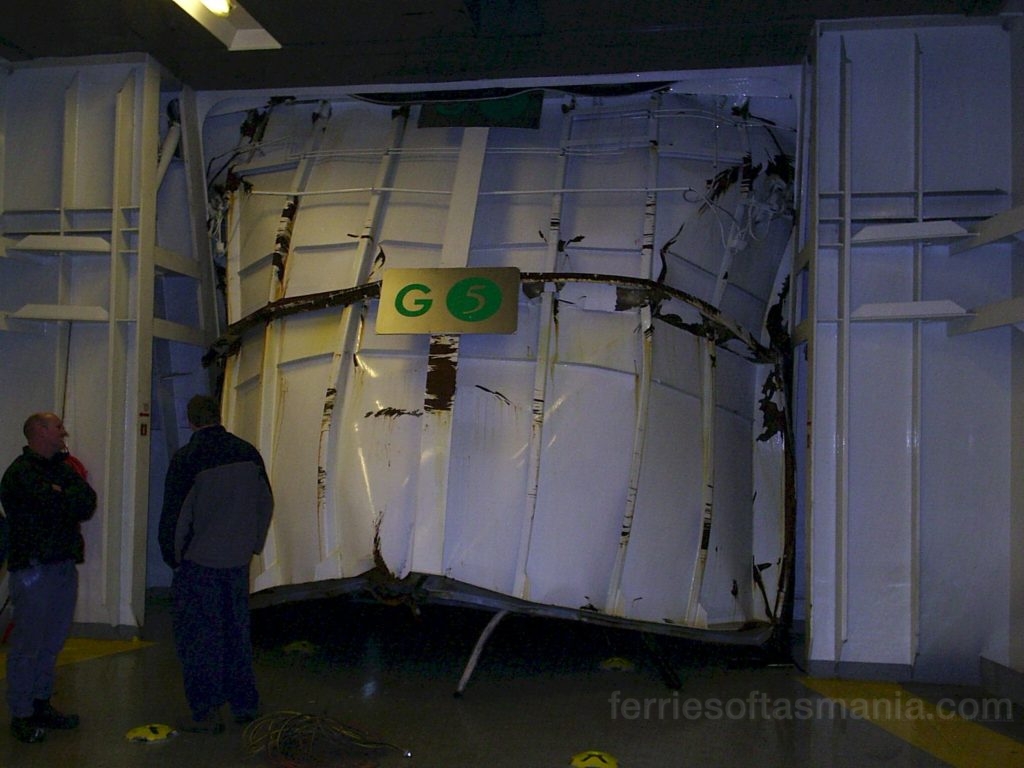
Photo: Mitchell Bruce collection

Scan: Mitchell Bruce collection, Advocate newspaper.
On 7/6/04 Spirit of Tasmania III was delayed from docking in Devonport for a few hours, due to a stolen car being driven off the link span into the river, meaning it was a navigation hazard. A crane came in and divers connected the cable to the car and it was lifted out.
In August of 2004 Spirit of Tasmania III was taken off the Devonport – Sydney line and placed on the Devonport – Melbourne line to cover the dry docking of Spirit of Tasmania I & II in Sydney. Once placed back on the Sydney run, she maintained only two return crossings a week, for the quiet winter season, until the beginning of September when she was back to three a week..

Photo:© Mitchell Bruce
Over the first year of route, the service to Sydney was under preforming. In Febuary 2005 the Tasmanian Government announced a bail out package of AUD$ 115 million to subsidize the service for three years. But by May 2006 it was becoming harder for TT-Line to continue, with rising fuel costs and low passenger numbers. There was much campaigning to save the ship, but on 5/6/2006 the Tasmanian Government announced the cessation of the service to Sydney and the Spirit of Tasmania III to be be sold.
On the 10/7/06 it was announced Corsica Ferries (Tourship Italia) were the buyers, being the the highest bidder in a “sealed-bid auction”. Some other companies had inspected the ship, including Brittany Ferries.
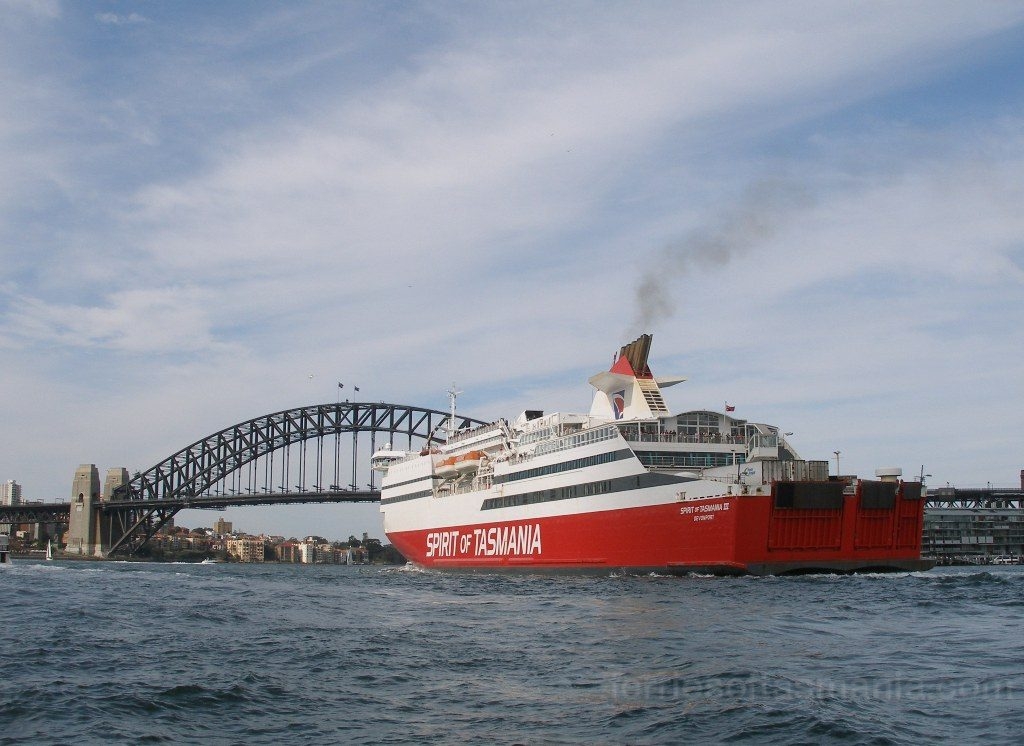
Photo:© Mori Flapan
On 19/8/06 Spirit of Tasmania III left Devonport for the final northbound crossing to Sydney. Once she had arrived, the next day she entered the Garden Island dry dock in Sydney harbor. She remained here for a few days to have a fin stabilizer re installed, after it had been removed at a dry docking in Brisbane a few months earlier. It had been damaged by abandoned fishing equipment off Flinders Island in Bass Strait. Some senior staff of Corsica Sardinia Ferries inspected the vessel in dry dock whilst she was there also.
On 27/8/06 Spirit of Tasmania III departed Sydney for the final time, arriving in Devonport the next day. She then relieved on the Melbourne Devonport route for a week, whilst Spirit of Tasmania I went to Sydney to be dry docked.
On the 4/9/06 Spirit of Tasmania III left Devonport for the last time, and headed to Melbourne, where she docked at Station pier. She was de stored and on the 6/9/06 Spirit of Tasmania III was handed over to her new owners, Corsica Sardinia Ferries. A flag changing ceremony was held. She remained alongside in Melbourne for three days, she then departed for Europe.
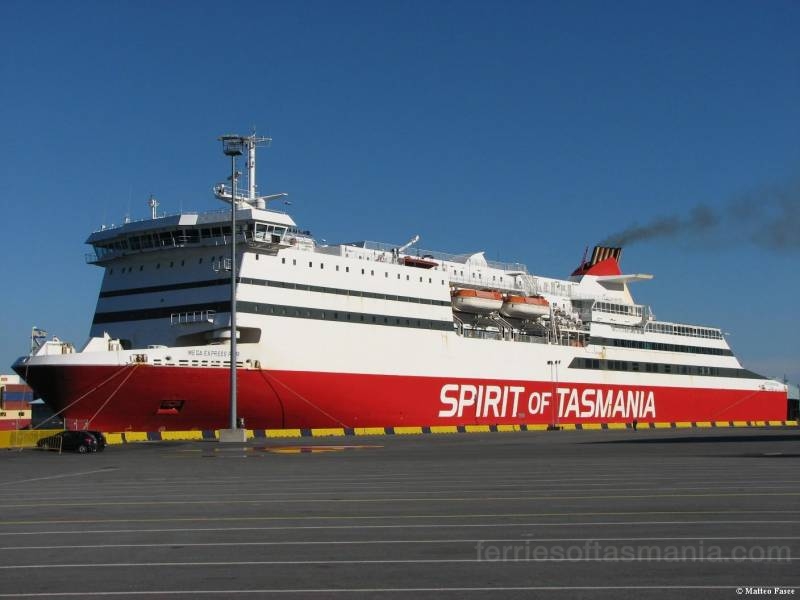
Photo: © Matteo Fasce
Mega Express Four sailed through the familiar waters of the South Pacific Ocean past Sydney, continuing up to Gladstone, where she called for Bunkers on 12/9/06. leaving Australia for good she headed to Singapore, for bunkers, then through the Suez canal. She arrived in Vado Ligure (Italy) on the 5/10/06, completing her voyage from Australia. She stayed there for ten days whilst works were done to her interior. Then on the 15/10 she sailed to Genoa to dry docked. Whilst she was there, she was painted in Corsica Ferries Yellow livery. She entered on service the 6/11/06. Her maiden voyage was from from Savona to Bastia. Mega Express Four then entered on Toulon – Bastia (Corsica) and Ajaccio (Sardinia) routes.
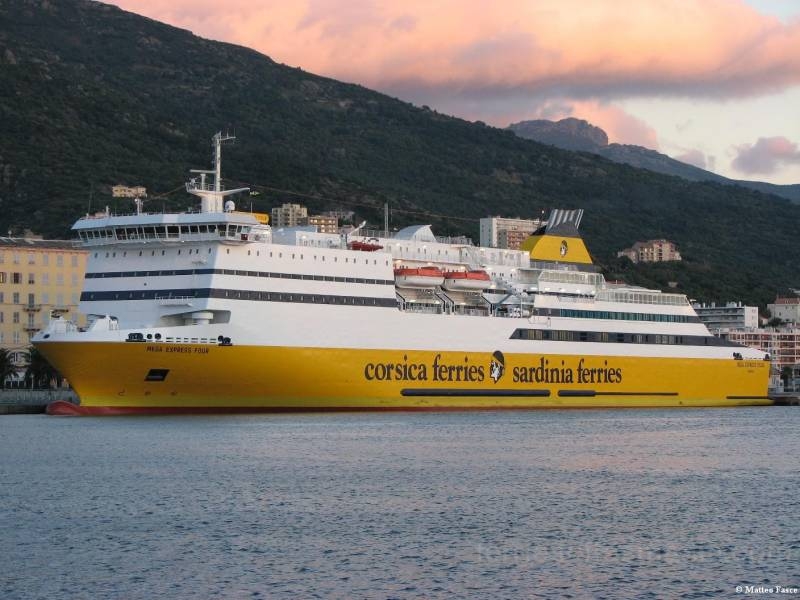
Photo: © Matteo Fasce
Mega Express Four sailed for the first few months essentially like she had been in Tasmania (With a few minor changes). In January of 2007 she sailed for Greece, arriving at Megatechnica ship yard at Perama (Near Piraeus) on 10/1/07 for rebuilding. The works carried out included extending the superstructure to the stern, over the previous car deck area. In that area there was previously the open car deck of G5. They also installed a new reception and cabins above that, on deck 6. The new reception is accessed via the old car deck water tight door half way up the escalator (which remains open all the time).
On deck 7 an extension of lounge area, deck 8 a new swimming pool, bar and open deck space. Amidships where the old shops and air seat lounge/ cinema were, they turned into a restaurant. Also the installation of proper ship air conditioning to supply the new additions on the aft, as well as in the old southern cross atrium/ old pool deck, which was left the same as her Tasmanian days, except new tables. On the 29/4/07, after four months of work Mega Express Four left Greece and sailed back to Italy to commence her trade of sailing various routs between Italy, France to the islands of Corsica and Sardinia. In summer she sails at 25kn for day crossings. I’m told this is her new top speed, as all the extra weight slows her down. On night sailings and in winter she sails at about 18kn-20kn.

Photo:© Mitchell Bruce

Photo:© Mitchell Bruce
In May 2018 I was lucky enough to sail with Mega Express Four, from Livorno, near Florance Italy, to Golfo Aranci in northern Sardinia on a night sailing. I found the ship to be in very good condition. Although I must say I was disappointed in the modifications made. The aft section around the reception, on the old car deck emits large amounts of rattles from the vibrations of the engines, one of the main reasons the designers for Superfast never extended the superstructure aft over the engines. The new restaurant, amid ships was a bit of a shambles in my opinion. The area is placed over the old hallway to the main stairwell. So now people who do not use the lift must walk through the middle of a restaurant with people eating, to get to their cabin. There is no designated walkway whats so ever. Even dogs are coming through the dinning area to access the out side decks. I mentioned this to a crew, but he just shrugged, as to say no comment. The new open pool deck was quite good though. Also some of the old crew accommodation has been opened up for passenger accommodation, as the there are too many crew cabins, with some of the Italian crew sharing the additional cabins installed for her Australian crew, making some surplus on deck 9 .
On the 7/2/2021 Mega Express Four departed Vado Ligure, Italy for Dublin, Ireland on charter to Irish ferries to sail the Dublin – Holy head route as freight only.
Gallery
Spirit of Tasmania III:
Superfast II / Mega Express Four



